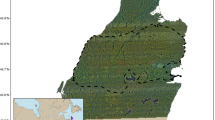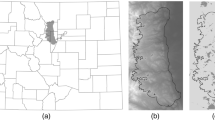Abstract
Studies of at-risk species are likely to have greater conservation impact if they: involve managers in question formulation, set specific management or restoration goals, and are based on detailed knowledge of species’ resource needs. These ideas guided our investigation of the foraging behavior of larvae of a US federally threatened butterfly, the Oregon silverspot (Speyeria zerene hippolyta), with the goal of making management recommendations for habitat restoration. S. z. hippolyta larvae feed exclusively on Viola adunca and must consume multiple individuals to pupate successfully. Larvae forage at random through meadow vegetation to locate host plants. Observations of larvae foraging under field conditions revealed that larger, older larvae move more rapidly and turn less acutely than smaller, younger larvae; the consequence of these developmental differences is that younger larvae tend to remain in one place while older larvae tend to range more widely, presumably in search of new host plants. Results from a simulation model initialized with these data suggested that a host plant density of at least four V. adunca plants/m2 (depending on predation intensity to which larvae are exposed) is required in order for 4th instar larvae to have a 10 % chance of survival to pupation. These findings are being used to guide a violet restoration program for this sensitive species.





Similar content being viewed by others
References
Andren H (1994) Effects of habitat fragmentation on birds and mammals in landscapes with different proportions of suitable habitat: a review. Oikos 71:355–366
Arlettaz R, Schaub M, Fournier J, Reichlin TS, Sierro A, Watson JEM, Braunisch V (2010) From publications to public actions: when conservation biologists bridge the gap between research and implementation. Bioscience 60:835–842
Bauerfeind SS, Fischer K (2009) Effects of larval starvation and adult diet-derived amino acids on reproduction in a fruit-feeding butterfly. Entomol Exp et Appl 130:229–237
Bierzychudek P, Warner KA, McHugh A, Thomas L (2009) Testing the host-finding ability of a monophagous caterpillar in the field. Ecol Entomol 34:632–637
Bukovinszky T, Potting RPJ, Clough Y, van Lenteren JC, Vet LEM (2005) The role of pre- and post-alighting detection mechanisms in the responses to patch size by specialist herbivores. Oikos 109:435–446
Cabin RJ, Clewell A, Ingram M, McDonald T, Temperton V (2010) Bridging restoration science and practice: results and analysis of a survey from the 2009 Society for Ecological Restoration International Meeting. Restor Ecol 18:783–788
Cain ML (1985) Random search by herbivorous insects: a simulation model. Ecology 66:876–888
Calenge C (2006) The package adehabitat for the R software: a tool for the analysis of space and habitat use by animals. Ecol Model 197:516–519
Campbell A (2007) An investigation into the conservation impact of research published in the scientific literature. MSc Dissertation, Imperial College London
Chapman DS, Dytham C, Oxford GS (2007) Landscape and fine-scale movements of a leaf beetle: the importance of boundary behaviour. Oecologia 154:55–64
Crist TO, Guertin DS, Wiens JA, Milne BT (1992) Animal movement in heterogeneous landscapes: an experiment with Eleodes beetles in shortgrass prairie. Funct Ecol 6:536–544
Crone EE, Pickering D, Schultz CB (2007) Can captive rearing promote recovery of endangered butterflies? An assessment in the face of uncertainty. Biol Conserv 139:103–112
Dover J, Settele J (2009) The influences of landscape structure on butterfly distribution and movement: a review. J Insect Conserv 13:3–27
Dray S, Royer-Carenzi M, Calenge C (2010) The exploratory analysis of autocorrelation in animal-movement studies. Ecol Res 25:673–681
Fahrig L (2003) Effects of habitat fragmentation on biodiversity. Annu Rev Ecol Evol Syst 34:487–515
Goodwin BJ, Fahrig L (2002) Effect of landscape structure on the movement behavior of a specialized goldenrod beetle, Trirhabda borealis. Can J Zool 80:24–35
Heisswolf A, Ulmann S, Obermaier E, Mitesser O, Poethke HJ (2007) Host plant finding in the specialized leaf beetle Cassida canaliculata: an analysis of small-scale movement behavior. Ecol Entomol 32:194–200
Henry EH, Schultz CB (2013) A first step toward successful conservation: understanding local oviposition site selection of an imperiled butterfly, mardon skipper. J Insect Conserv 17:183–194
Kareiva PM, Shigesada N (1983) Analyzing insect movement as a correlated random walk. Oecologia 56:234–238
Laurance WF, Lovejoy TE, Vasconcelos HL, Bruna EM, Didham RK, Stouffer PC, Gascon C, Bierregaard RO, Laurance SG, Sampaio E (2002) Ecosystem decay of Amazonian forest fragments: a 22-year investigation. Conserv Biol 16:605–618
Lindenmayer DB, Fischer J (2006) Habitat fragmentation and landscape change: an ecological and conservation synthesis. Island Press, Washington, DC
Lloyd H, Marsden SJ (2011) Between-patch bird movements within a high-Andean Polylepis woodland matrix landscape: implications for habitat restoration. Restor Ecol 19:74–82
Lund U (S-plus original) and Agostinelli C (R-port) (2009) CircStats: Circular Statistics, from “Topics in Circular Statistics” (2001) R package version 0.2-4. http://CRAN.R-project.org/package=CircStats
McIntyre NE, Wiens JA (1999) Interactions between landscape structure and animal behavior: the roles of heterogeneously distributed resources and food deprivation on movement patterns. Landsc Ecol 14:437–447
Miller JR, Hobbs RJ (2007) Habitat restoration—do we know what we’re doing? Restor Ecol 15:382–390
Milner-Gulland EJ, Fisher M, Browne S, Redford KH, Spencer M, Sutherland WJ (2009) Do we need to develop a more relevant conservation literature? Oryx 44:1–2
Milner-Gulland EJ, Barlow J, Cadotte MW, Hulme PE, Kerby G, Whittingham MJ (2012) Ensuring applied ecology has impact. J Appl Ecol 49:1–5
Nams VO (1996) The VFractal: a new estimator for fractal dimension of animal movement paths. Landsc Ecol 11:289–297
New TR (2007) Understanding the requirements of the insects we seek to conserve. J Insect Conserv 11:95–97
New TR, Pyle RM, Thomas JA, Thomas CD, Hammond PC (1995) Butterfly conservation management. Annu Rev Entomol 40:57–83
Nolet BA, Mooij WM (2002) Search paths of swans foraging on spatially autocorrelated tubers. J Anim Ecol 71:451–462
Oates MR (1995) Butterfly conservation within the management of grassland habitats. In: Pullin AS (ed) Ecology and conservation of butterflies. Chapman and Hall, London, pp 98–112
Opler PA (1995) Conservation and management of butterfly diversity in North America. In: Pullin AS (ed) Ecology and conservation of butterflies. Chapman and Hall, London, pp 316–324
Pollard E, Eversham BC (1995) Butterfly monitoring 2—interpreting the changes. In: Pullin AS (ed) Ecology and conservation of butterflies. Chapman and Hall, London, pp 23–36
Potting RPJ, Perry JN, Powell W (2005) Insect behavioural ecology and other factors affecting the control efficacy of agro-ecosystem diversification strategies. Ecol Model 182:199–216
Romero S, Campbell JF, Nechols R, With KA (2009) Movement behavior in response to landscape structure: the role of functional grain. Landsc Ecol 24:39–51
Roslin T, Syrjälä H, Roland J, Harrison PJ, Fownes S, Matter SF (2008) Caterpillars on the run—induced defences create spatial patterns in host plant damage. Ecography 31:335–347
Scharf I, Kotler B, Ovadia O (2009) Consequences of food distribution for optimal searching behavior: an evolutionary model. Evol Ecol 23:245–259
Schultz CB (1998) Dispersal behavior and its implications for reserve design in a rare Oregon butterfly. Conserv Biol 12:284–292
Sei M (2009) Flight and oviposition behavior of the adult maritime ringlet (Coenonympha nipisiquit McDunnough) females in response to microhabitat. J Insect Behav 22:87–100
Settele J, Kühn E (2009) Insect conservation. Science 325:41–42
Thomas JA, Simcox DJ, Clarke RT (2009) Successful conservation of a threatened Maculinea butterfly. Science 325:80–83
Thomas JA, Simcox DJ, Hovestadt T (2011) Evidence based conservation of butterflies. J Insect Conserv 15:241–258
Thorpe AS, Stanley AG (2011) Determining appropriate goals for restoration of imperiled communities and species. J Appl Ecol 48:275–279
Turchin P (1998) Quantitative analysis of movement: measuring and modeling population redistribution in animals and plants. Sinauer Associates, Sunderland
Turchin P, Odendaal J, Rausher MD (1991) Quantifying insect movement in the field. Environ Entomol 20:955–963
U. S. Fish and Wildlife Service (2001) Oregon silverspot butterfly (Speyeria zerene hippolyta) revised recovery plan. U. S. Fish and Wildlife Service, Portland
Warner KA, Bierzychudek P (2009) Does marking with fluorescent powders affect the survival or development of larval Vanessa cardui? Entomol Exp Appl 131:320–324
Wiens JA, Crist TO, Milne BT (1993) On quantifying insect movements. Environ Entomol 22:709–715
Wint W (1983) The role of alternative host-plant species in the life of a polyphagous moth, Operophtera brumata (Lepidoptera: Geometridae). J Anim Ecol 52:439–450
Zollner PA, Lima SL (1999) Search strategies for landscape-level interpatch movements. Ecology 80:1019–1030
Acknowledgments
Larvae were captively-reared by M. J. Anderson and many student interns at the Oregon Zoo. A. McHugh and L. Thomas assisted with fieldwork. A. Walker and the U. S. Fish and Wildlife Service granted permission to work with Speyeria zerene hippolyta, under recovery permit TE125973. We benefitted from the advice and encouragement of C. Schultz, who also provided comments on an earlier draft, and from members of the Oregon silverspot butterfly Working Group. In particular, the collaboration and support of D. McCorkle and of D. Pickering and The Nature Conservancy’s Oregon staff have been invaluable. The manuscript was improved by suggestions provided by anonymous reviewers. Financial support was provided by Lewis and Clark College, the M. J. Murdock Charitable Trust, and the U. S. Fish and Wildlife Foundation. These funding sources had no role in the study’s design or execution, or in the preparation of this report.
Author information
Authors and Affiliations
Corresponding author
Rights and permissions
About this article
Cite this article
Bierzychudek, P., Warner, K. Modeling caterpillar movement to guide habitat enhancement for Speyeria zerene hippolyta, the Oregon silverspot butterfly. J Insect Conserv 19, 45–54 (2015). https://doi.org/10.1007/s10841-014-9741-6
Received:
Accepted:
Published:
Issue Date:
DOI: https://doi.org/10.1007/s10841-014-9741-6




